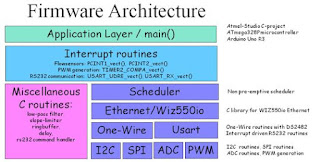- Get link
- X
- Other Apps
- Get link
- X
- Other Apps
- Firmware refers to the
microprograms present on ROM (Read Only Memory) modules, which contain
low-level (e.g., hexadecimal, machine code) software. They enable the device on
which they are present to take stock of its capabilities and to render those
capabilities functional.
- The information loaded onto the ROM is non-volatile meaning that it is not lost when power is switched off. The most basic example of firmware would be the BIOS that comes with the motherboard of your PC. The firmware also coordinates the activities of the hardware during normal operation and contains programming constructs used to perform those operations.
- The use of firmware gives more flexibility compared to the use of pure hardware circuitry. For example, in a typical modem, the firmware will be a factor in establishing the modem’s data rate and command set recognition.
FIRMWARE UPDATION ON A CAMERA
- Some firmware are non-rewriteable while others are upgradeable, meaning that it is possible to upgrade the firmware of the device by connecting it to your PC in a particular configuration and then running the software provided by the manufacturer. This process is called “flashing firmware” or simply “flashing”.
- This becomes necessary when the device becomes incompatible with newer operating systems or to simply enhance the performance of the device. For example, CD and DVD drive manufacturers often release firmware updates available that allow the drives to read faster media.
EVOLUTION OF FIRMWARE
- BIOS : A basic input/output system (BIOS) is a preinstalled program used during start-up Windows-based computers. The CPU initially accesses the BIOS, after which the operating system is loaded.A basic input/output system is also known as system BIOS or ROM BIOS.

- Unified Extensible Firmware Interface (UEFI): Like BIOS (Basic Input Output System) is a firmware that runs when the computer is booted. It initializes the hardware and loads the operating system into the memory. However, being the more modern solution and overcoming various limitations of BIOS, UEFI is all set to replace the former.
Firmware vs.
Software difference
- Often, the word Firmware and software are used interchangeably, i.e., single or a collection of computer programs assigned with some task to do on the machine. But in reality, it’s the work that defines the roots of these categories (firmware and software) in which we put them.

- For example, software is virtual so it can be Copied, Changed, and Destroyed. It is often stored in memory that is easily accessible and even replaceable by the user. But in the case of firmware, the memory that it stores is often embedded in the device itself and is not replaceable by the user. This is done deliberately to prevent any tampering or removing as it is critical for the device to run and can cause serious consequences if removed.
Also, software is often upgraded, and so the information stored in it is often modified/altered with each execution of the application. In contrast, the firmware does not really change much unless you modify the settings very often. There is also very little or no requirement to change the firmware of a device.
- Get link
- X
- Other Apps



Comments
Post a Comment